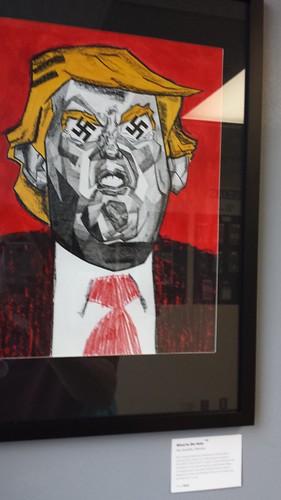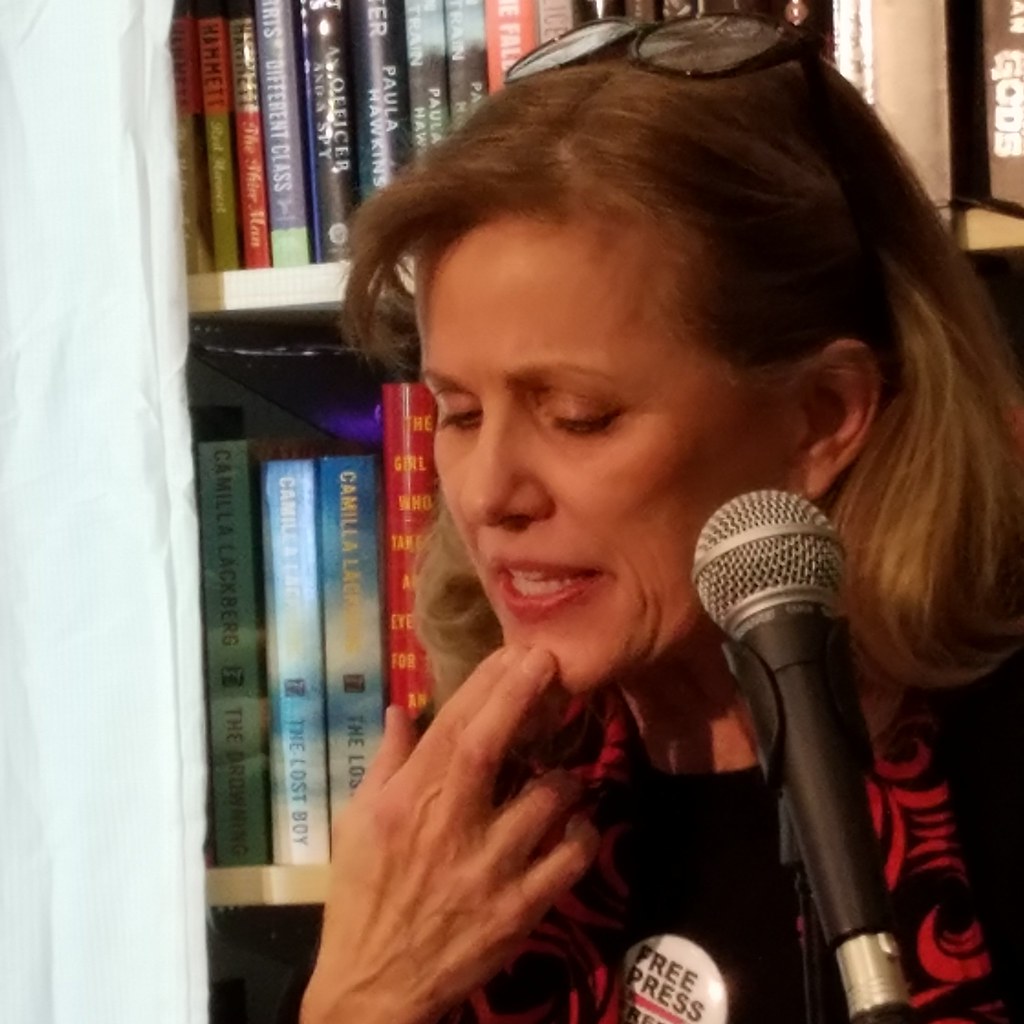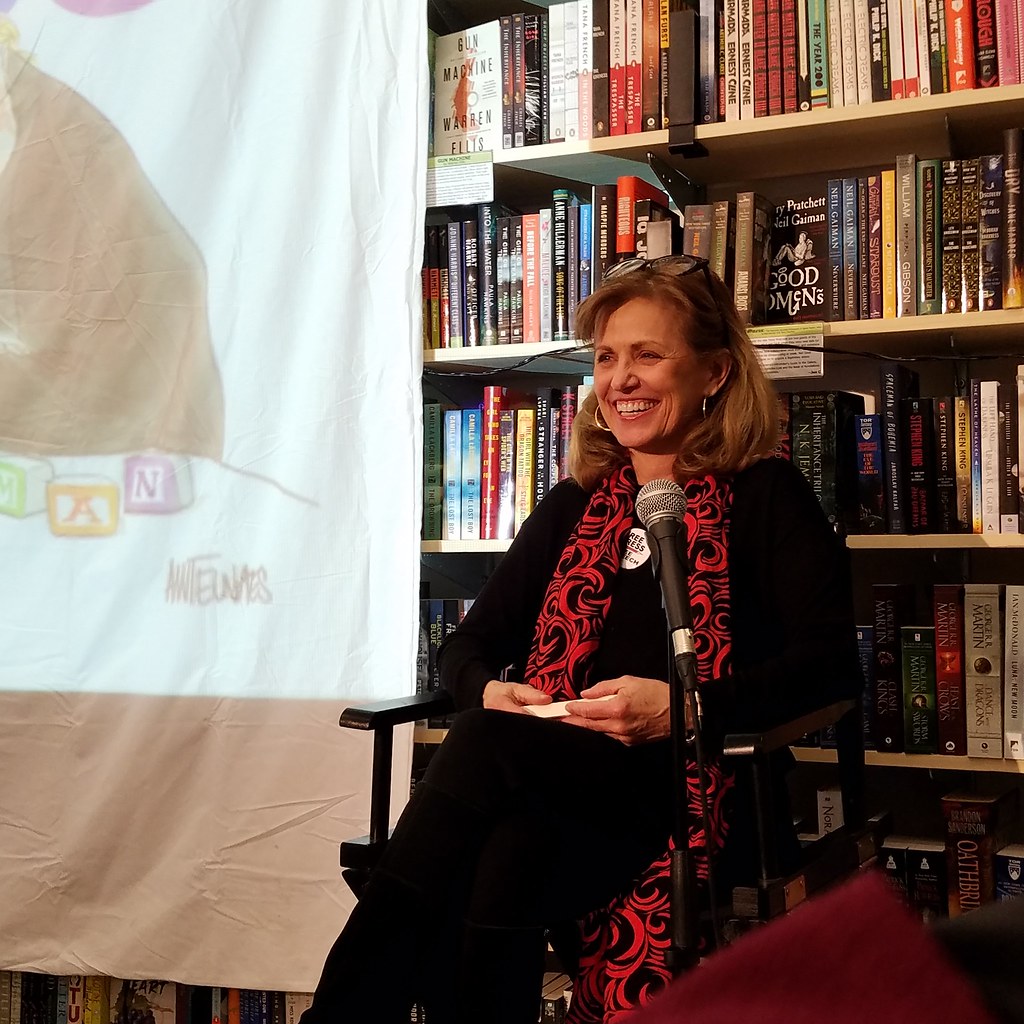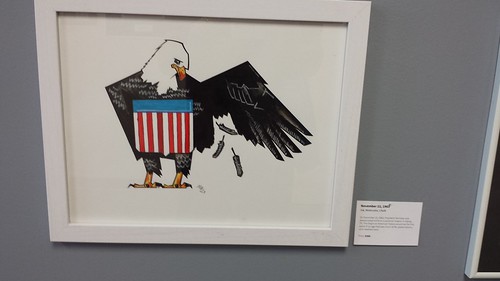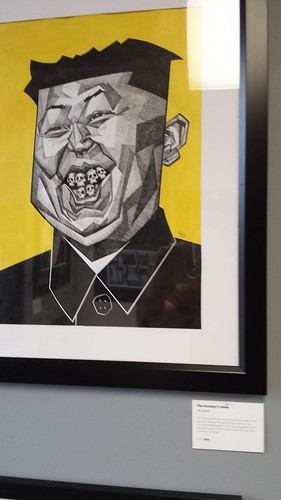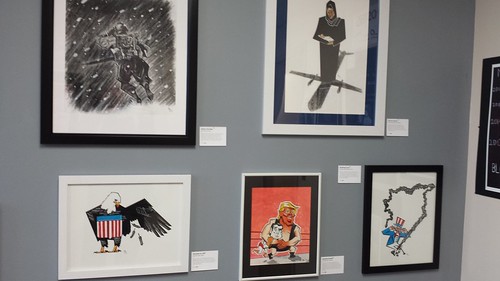Sunday, February 25, 2024
Wednesday, February 14, 2024
Catching up with Alan Jenkins for 1/6 issue #2
Last year I spoke with Professor Alan Jenkins about 1/6, a serialized comic book about what if Donald Trump had succeeded in stealing the 2020 presidential election via insurrection. I encourage you to read that interview before carrying on here as Alan and I caught up via telephone about issue #2 which came out last month.
Mike Rhode: 1/6, issue number two, a double size issue, came out in January. This one's almost completely dedicated to recapping the reality of the events of the 2020 election, and then the insurrection, or riot or whatever happened in DC on January 6th. In our previous interview, you had said that you had hoped to wrap up the entire book by this January. So what happened?
Alan Jenkins: <laughs>
So events continued to unfold. We thought that we had the information we needed
to fill this series out, but then came the January 6th House hearings,
indictments, Supreme Court arguments, all kinds of real-life events, many of
which we thought were too compelling not to include. And so [coauthor] Gan
[Golan] and I found ourselves writing, and rewriting, and then eliminating,
because at the end of the day, we want this to be a compelling, entertaining
story, not, as our artist Will Rosado says, a lawyer's PowerPoint. We crammed a
lot in, and then we had to scale some of it back and figure out the most
entertaining and informative way to tell this story. A lot of the delay was due
to that. And also to the fascinating process of comic book publishing.
 |
| Jamal Igle cover |
Alan Jenkins: We always thought that issue two would be
more substantial, because we knew from the beginning that whereas issue one is
set about nine months after the fictional successful insurrection, issue two
was going to jump back to the events leading up to the insurrection and include
a lot of real events. It's still historical fiction, but it includes a lot of
documented events. And we knew that we were going to need space to tell that story
and to also include our characters. So we always knew it was going to be bigger
than the first. We didn't know what the exact page number was going to be, but
a double issue seemed right to us.
Mike Rhode: Speaking of the true life events that are
included, I was wondering about who suggested the varying panel styles for
truth, assumptions, and straight fiction. A lot of times this is done in a
comic with coloring, but I think it worked extremely well with the panel
borders in this instance.
Alan Jenkins: I'm glad that it worked for you. We discussed a lot of different possibilities for distinguishing between these three categories: documented events, purely fictional events, and speculation. The speculation area is where we know that something happened. For example, Cassidy Hutchinson testified about conversations that were had in her presence, but we didn't know precisely who said what, what the room or the setting was. We wanted to be very clear about what we know and don't know, so we had those three categories. We did look at coloring for a while. We thought maybe we would over-saturate the fictional events and under-saturate the real events, but using different shapes of the panels, which was Gan's idea, seemed to work best.
Mike Rhode: When you start looking for it, it's pretty
clear, but the story reads very smoothly too. In fact, it's probably one of the
best reporting or nonfiction comics I've read recently. You talked a little bit
about how much research went into the issue, but realistically I assume that
this book had you reading quite a bit of legal documentation and then trying to
digest it down for an average reader. Would that be accurate?
Alan Jenkins: We consumed a huge amount of legal
information. We spoke with reporters and experts and others. I had two research
assistants who helped us in making sure that we got the facts right. It was a
hugely time-consuming process. Really interesting, and often very terrifying.
To give you an example, we spoke with a wonderful researcher, KatherineStewart, who studies the Christian Nationalist movements. She gave us a lot of
information about how they operate in the real world, and how they contributed
(in her view) to the insurrection. She actually has a documentary film coming
out, based on her book The Power Worshippers, that captures some of what's in
her reporting. It was really scary once we started to look at what some of
these folks are doing, what they did leading up to the insurrection, but we
absolutely wanted to include at least hints of those real events in the book.
We spent a lot of time collecting that information.
Mike Rhode: For your young man Travis whose father Clive survives him; the Christian nationalism is shown as they actually talked to a minister about whether or not Trump is really the president. I found that page quite interesting, as the minister was totally ignoring Christian values. <laugh>.
Alan Jenkins: We wanted to depict everyone, all of our
characters, with empathy. Our character Clive, who is a MAGA voter and a
Christian, was really grappling with what it means for religious leaders on the
right to be advocating violence, and to be denying the truth of what we see
with our own eyes. That was very much reflective of that research and of some
of the conversations that we had with everyday folks.
 |
| Rosado art |
Mike Rhode: The fictional characters did not get fleshed
out as much as they did in the first issue, but I think everybody got a few
pages right?
Alan Jenkins: That's right. We wanted to make sure that we
were catching up with all of our people, our characters. As you say, we weren't
able to give them as much ink in issue two, but for issues three and four,
they're going to come roaring back and we're going to see a lot more of all of
them and their interactions with each other.
Mike Rhode: What are your projected timelines for three
and four?
Alan Jenkins: Ah. <laughs> I'm always loath to
predict, but we're hoping to have issue three out around the start of summer
and issue four out before election day.
Mike Rhode: Are you hoping to have it compiled before
election day?
Alan Jenkins: I would love that, but I think realistically
the way the publishing world works, it's going to be difficult to do that with
a publisher. We might decide to bundle it ourselves, but I think the way you
reach a much larger mass audience is to work with publishers. We'll see what
the time frame is on that.
Mike Rhode: I noticed there are some additional artists
with this issue...
 |
| Moline's Pence |
Alan Jenkins: Yes, we brought on some new folks in
addition to our core team. I want to shout out Karl Moline, who really filled
in a lot. We had more work than Will, our main penciller and inker, was
available to do. Karl came in and did some really good work to fill out the
book. And we added a number of other folks, mostly because it was a lot of work
to do in a relatively short period of time. So we had to build the team.
Mike Rhode: It looks like the book's artwork was divided
up between people, because I can see a difference in the penciling. I'm
assuming that one person individually penciled some pages and the other person
penciled others.
Alan Jenkins: It definitely took a village. Will has really
perfected our characters, and so he did most of the work with our characters
throughout the book. And Karl has a particular talent for capturing real
people. When you look at Vice President Pence, Senator Cruz, and some of these
other folks, Karl took those and did a great job of making them, for the most
part, instantly recognizable.
Mike Rhode: Anyway, I didn't find the switch in artists to
be disruptive. It read smoothly, which doesn't always happen when you switch an
artist in the middle of a book. One of
the things that you said back in the first interview was that "Trump
doesn't get much ink. The book is in part about Trumpism and the transcendent
threats to democracy and equal dignity that he represents. But, if Trump went
away tomorrow, those forces would still exist. That's an important theme of the
book." That appears less true in the current issue. I think Trump, we
could argue, is one of the two major characters in this issue. Although,
surrounded by all his sycophants, maybe he's not in there as much as I thought
he was. Anyway, this one focused more on Trump. How did you feel about that
<laughs>?
 Alan Jenkins: This is historical fiction, but part of our
goal was to establish a record of what happened, especially when you have a lot
of people trying to deny the truth of what happened or mischaracterize it. We
wanted to convey that the insurrection actually had three parts, and we have a
diagram in the back indicating the three parts, but we also have to tell the
story. So one part was absolutely the violence, and that was the most shocking.
It also is the most visually striking. But
there was also the strong-arming of officials -- state and local officials, and
Mike Pence, the vice president at the time. [Third,] there was the sending of
fake electors to states, which is not visually interesting, but absolutely a
crucial part of the plan to overturn our democracy. We wanted to explain those
elements in ways that were visually interesting and entertaining. And yeah,
Trump was very much at the center of that. We didn't want to give him more ink
than we thought his role deserved in part, as I said last time, because we
think Trump hasn't gone away, but even if he went away tomorrow, we would still
be left with his legacy. We didn't want to make it all about him, but he was at
the center of what happened.
Alan Jenkins: This is historical fiction, but part of our
goal was to establish a record of what happened, especially when you have a lot
of people trying to deny the truth of what happened or mischaracterize it. We
wanted to convey that the insurrection actually had three parts, and we have a
diagram in the back indicating the three parts, but we also have to tell the
story. So one part was absolutely the violence, and that was the most shocking.
It also is the most visually striking. But
there was also the strong-arming of officials -- state and local officials, and
Mike Pence, the vice president at the time. [Third,] there was the sending of
fake electors to states, which is not visually interesting, but absolutely a
crucial part of the plan to overturn our democracy. We wanted to explain those
elements in ways that were visually interesting and entertaining. And yeah,
Trump was very much at the center of that. We didn't want to give him more ink
than we thought his role deserved in part, as I said last time, because we
think Trump hasn't gone away, but even if he went away tomorrow, we would still
be left with his legacy. We didn't want to make it all about him, but he was at
the center of what happened.
Mike Rhode: I think you did a pretty good job, as opposed
to our current mass media who continues to treat him as if he should be a
legitimate candidate. Going slightly off topic here, but do you have any
feelings about whether or not he should be on the ballot? <laugh>
 Alan Jenkins: You may have seen that in issue two, we have
a petition that readers can scan and sign to remove all Insurrectionists from
the ballot.
Alan Jenkins: You may have seen that in issue two, we have
a petition that readers can scan and sign to remove all Insurrectionists from
the ballot.
Mike Rhode: The page that's labeled 'Make your voice
heard.'
Alan Jenkins: Right, exactly. Pursuant to the
Constitution, to section three of the 14th Amendment. My own view, and I teach
the 14th Amendment, is that Trump clearly engaged in an insurrection after
swearing an oath, and I believe that he's covered by that provision of the 14th
Amendment. But the case is currently, as we speak, before the U.S. Supreme
Court, and they had oral arguments on February 8th and expressed some
skepticism about the idea that he can be barred, at least by the state of
Colorado, from running. So we'll know. We might not know by the time this
interview is out, but we will know this winter what the Supreme Court thinks
the Constitution says, and their word goes, while mine doesn't.
Mike Rhode: I don't quite understand because it's not like
[a candidate] can [automatically] be on the ballot of every state. Normally you
have to get a certain amount of signatures, and then the state has to decide
that to put you on the ballot. So I'm not quite sure why this suddenly became a
federalized issue, just like Bush v Gore [where the Constitutional mechanism of
using the House of Representatives to settle the issue was superseded]. I don't
quite understand why he suddenly has the absolute right to be on the ballot in
states.
Alan Jenkins: We knew it would get to the Supreme Court
eventually, because at the end of the day the secretaries of state and the
state courts are interpreting the federal constitution. So however it turned
out there would be the ability to seek review by the U.S. Supreme Court of how
the Constitution is interpreted. It would've been shocking if they had declined
to take up this case. I think an interesting thing, at least for us law geeks,
is that typically this very conservative Supreme Court believes strongly in states'
rights. The states have a very important role in administering elections under
our constitutional system. And now, at least in oral argument, we heard
Justices say essentially the opposite, which is, "how can you allow one
state to assume the power to enforce the 14th Amendment?" So it was
fascinating, making strange bedfellows for sure. We'll see what they decide.
 Mike Rhode: Getting back into your comic itself, are you
at a point of still being able to cover your costs for the book? I know you had
a Kickstarter [to start it]. Are you planning on another Kickstarter to finish
it?
Mike Rhode: Getting back into your comic itself, are you
at a point of still being able to cover your costs for the book? I know you had
a Kickstarter [to start it]. Are you planning on another Kickstarter to finish
it?
Alan Jenkins: We probably will do another Kickstarter.
We've been fortunate to have been able to raise a lot of money, which means in
turn, relatively speaking for the comic book world, we've been able to hire
top-notch artists and produce a quality book. I'm well aware there are a lot of
amazing creators who are not able to put together the resources to do that, and
unfortunately the end product suffers. We've been fortunate there. We almost
certainly will do another Kickstarter to finish up the series and also to make
sure we get it out, because it's [also] an infrastructure of distributing comic
books, which costs money. We've been very fortunate to have an amazing printer
and distributor, Sun Print Solutions in Utah. They're a union printer, which
was very important to us, and they’ve just been fantastic. Not only in printing
the book, but in helping us to get it out into the world. We’ll be going back
to them and they’ve gotta get paid, so we’ll, we’ll be raising some more money.
Mike Rhode: You spoke about the difficulties in distribution and I imagine you’re still looking for mechanisms to get it into comic bookstores. Since the distribution market in American comics is continuing to shatter, have you’ve found a distributor yet?
Alan Jenkins: No.
We’ve sold thousands of copies of issue one, overwhelmingly through
Amazon and our Shopify site, which is https://onesixcomicsstore.com. We have
reached some comic bookstores that are selling the series largely through shoe
leather—literally walking to stores and showing them the book, letting them see
that it's a quality book, both in terms of the art and storytelling and in
terms of the quality of production. Most of the places where we've handed them
a sample and said, "Hey, do you want to sell some of these?" they've
said yes. But that can't be our
distribution model. We can't be [going] everywhere. And many of the places where
we most want to sell the book through stores are in the Midwest and the South.
We are reaching those places through Amazon and Shopify, but we really want to also
reach those people who just come into the comic bookstore looking for something
interesting and new and see our book. Not because they're interested in the
insurrection per se, but because they want a good story. That [audience] we
have not yet been able to crack via stores.
 |
| Martinbrough variant |
Mike Rhode: Another part of the comic book market that
you've advertised in both issues is variant covers [on of which is by local cartoonist Shawn Martinbrough]. Are those available yet?
Alan Jenkins: The variant cover for issue one is available,
and we're making them mostly available through stores at this point because we
want to make sure we're limiting supply. The variant cover for issue number two
is not yet done, but will be a very familiar riff on a popular series when
people see it.
Mike Rhode: Just to confirm, the varying covers are in
fact not available on shop on your Shopify site?
Alan Jenkins: That's correct.
Mike Rhode: Alright, because that of course is a great way
to make money off comic fans. I know you're a comic fan and I personally would
give you guys more money by buying the varying covers just because I believe in
the project.
Alan Jenkins: I won't bore you with the details of setting
up new sales channels, but we have to figure out when it's the right time to do
that.
Mike Rhode: Is there anything that I have not asked you
that we should talk about?
 Alan Jenkins: I would just say that this is the moment for
this story, and we really want to engage as many people as we can. I hope your
readers will consider reaching out to their comic book store to say, "Hey,
we wish you would order this. " We are definitely marketing, both email
and mail, to comic bookstores. We are also making hundreds of free copies
available, as we did last time with issue one, to public libraries, to school
libraries, to colleges and universities, to pro-democracy organizations, and
that's an important part of this effort. That's, in part, the reason we raised
outside money -- so that we could get the story out to people who might not otherwise
have the resources, or even the access, to purchase it. We want it to be in
their hands for free. That's an important part of our mission as well.
Alan Jenkins: I would just say that this is the moment for
this story, and we really want to engage as many people as we can. I hope your
readers will consider reaching out to their comic book store to say, "Hey,
we wish you would order this. " We are definitely marketing, both email
and mail, to comic bookstores. We are also making hundreds of free copies
available, as we did last time with issue one, to public libraries, to school
libraries, to colleges and universities, to pro-democracy organizations, and
that's an important part of this effort. That's, in part, the reason we raised
outside money -- so that we could get the story out to people who might not otherwise
have the resources, or even the access, to purchase it. We want it to be in
their hands for free. That's an important part of our mission as well.
Mike Rhode: Speaking of freebies, did you send it to members of Congress again with the second issue?
Alan Jenkins: Yes, we did. We sent it to all of the
election deniers in Congress, of which there are over 150, and also sent it to
some of the constitutional heroes from 1/6 in Congress in both parties.
Mike Rhode: Did you hear back from anybody this time?
Alan Jenkins: No, haven't heard. I met at, San Diego
Comic-Con, Robert Garcia a congressman who actually took the oath of office on
[the Library of Congress'] copy of Action Comics number one. He expressed
interest, so we'll see whether there's something we can cook up with him.
Mike Rhode: Last time we talked about the comic's African-American component, but it's much less present this time, since the Republican MAGA are a largely white phenomena, so I'll just hold that question until we talk about issue three.
1/6 #1-2 are available now at https://onesixcomicsstore.com/
Monday, November 05, 2018
Meet John Darrin: A Chat About His Anti-Trump Cartoon Book
Early this fall, some of my friends among local political cartoonists started telling me that they had a piece in a new book. Author John Darrin commissioned over a score of cartoonists to illustrate Who's That Man with Mr. Lincoln, Mommy? A Parent's Guide to the Trump Presidency. Darrin himself is from Frederick, MD, and local cartoonists in the book are Steve Artley, Barbara Dale, Al Goodwyn, Clay Jones and Joe Sutliff (see the bottom of this post for his list of all the contributors).
Darrin's website describes his book thusly:
Who’s That Man With Mr. Lincoln, Mommy? is a political parody intended to discredit the Trump Administration in a simple, compelling, and entertaining way. Set as a walking tour of the Mall in Washington, DC, two young parents and their children play the alphabet game to explain why President Trump is the greatest. The children unwittingly expose their parent’s absurd explanations with common sense. Interlaced with penetrating editorial cartoons from award-winning artists, this no-holds-barred tale takes us on a journey through the deception and hypocrisy of the Trump White House.
The slim volume (there are only 24 letters in the alphabet after all) features a page of text with an illustration and his imaginary family discussing a word that has gained prominence (or notoriety) due to the Trump administration. The facing page reproduces a political cartoon and a brief biography of the cartoonist.
Darrin was kind enough to send me a copy to preview and answer some questions for ComicsDC.
You're normally a novelist? Why did you decide to write a children's book parody?
Yes, I am a novelist, and also some business-based non-fiction. A parody of a children's book allowed me to present the pro-Trump arguments in the shortest and simplest form and have them rebutted not by partisanship and ideology, but by simple common sense and honest questions.
And why have it illustrated by cartoonists?
 |
| Steve Artley's drawing from the Lincoln Memorial |
How did you find them?
Lots of research and queries. Lists like Pulitzer and Herblock prize winners, the Association of American Editorial Cartoonists, and different cartoon syndicators. Then lots of correspondence to sell the concept.
I made a comprehensive list of words that would apply to Trump's administration (page 62 of the book) and picked the ones that I felt were most important. For example. using pussy or Putin as the "P" word was an obvious choice. But I wanted this to be a catalog of Trump's failings and Puerto Rico was no longer on people's minds. With the daily barrage of lunacy, it is easy to forget earlier offenses to the American legacy. Several of my choices were changed by the cartoonist to fit their interests, such as Ingrid Rice, a Canadian cartoonist, choosing NAFTA over narcissism.
Yes, the story was drafted and then the cartoonists drew to the subject and narrative.
 |
| Joe Sutliff's drawing of the Trump Hotel (aka the Old Post Office) |
The book is available on our website and on Amazon. We have been trying to get it placed in retail stores, but we don't have a wholesaler so we'll continue to work on that.
There are two sequels planned: Who's That Man Scolding Mr. Trump, Mommy?, and Who's That Man Looking So Sad, Mommy?, about the Mueller investigation and the mid-term results, respectively.
Thursday, January 25, 2018
Ann Telnaes Q&A at Politics and Prose
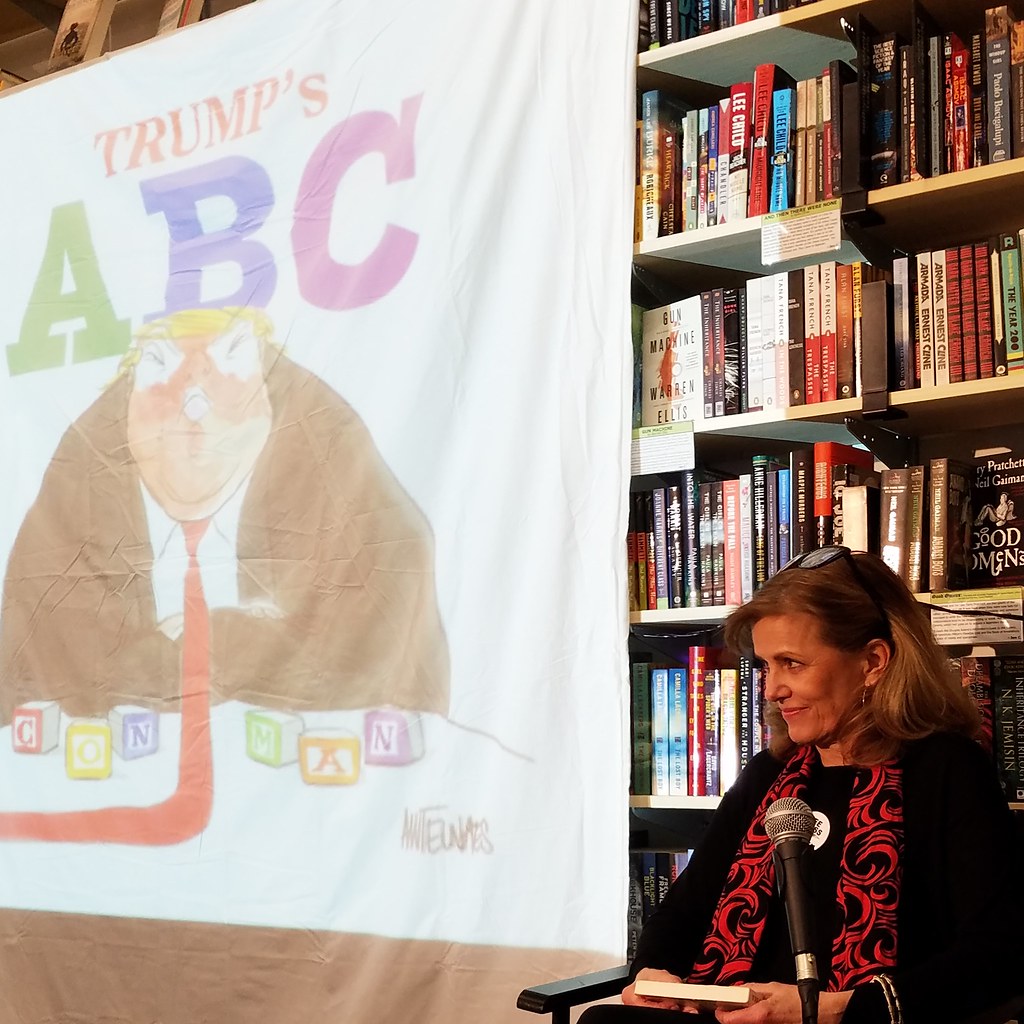 After she read Trump's ABC, her new book of caricatures about the administration, Ann Telnaes took questions from the audience for about thirty minutes. With her permission, I've transcribed them.
After she read Trump's ABC, her new book of caricatures about the administration, Ann Telnaes took questions from the audience for about thirty minutes. With her permission, I've transcribed them.  I put it aside and I happened to take a road trip down to Savannah during the holidays. I had a nine hour drive down and a nine hour drive back. I was driving, because my dog doesn’t, and I didn’t have my hands free to do any sketches. I was thinking about a suggestion a friend had given me, which was to do a political ABC book. Since my hands weren’t free, I put my phone on, and started to recite, “A is for blah, B is for blah...” and I kept doing that all the way down to Savannah and all the way back up. By the time I got back to D.C. I had a book.
I put it aside and I happened to take a road trip down to Savannah during the holidays. I had a nine hour drive down and a nine hour drive back. I was driving, because my dog doesn’t, and I didn’t have my hands free to do any sketches. I was thinking about a suggestion a friend had given me, which was to do a political ABC book. Since my hands weren’t free, I put my phone on, and started to recite, “A is for blah, B is for blah...” and I kept doing that all the way down to Savannah and all the way back up. By the time I got back to D.C. I had a book.  Oh god. You’re right. The only thing I find wanting in this book is that there’s other things I want to address. Maybe I can do a counting book.
Oh god. You’re right. The only thing I find wanting in this book is that there’s other things I want to address. Maybe I can do a counting book. Q: Since Trump is famously thin-skinned, do you know to what extent he has objected to your cartoons?
Q: Since Trump is famously thin-skinned, do you know to what extent he has objected to your cartoons? I think it’s going to go on for a while. I really do. There was a short time right after he became president where I thought “Maybe this is going to be over quickly.” The problem is, and this is what I do my most critical cartoons on, the Republican leadership is the enablers. They are the reason we are still at this point. They have decided that they are going to keep this man in office as long as he is useful to them. And unfortunately, I think that the way Trump operates, and what he responds to, and what he wants out of this… it’s going to be a back-and-forth situation. We’re just going to have to roll along with it. Unfortunately, I think it’s going to take a while.
I think it’s going to go on for a while. I really do. There was a short time right after he became president where I thought “Maybe this is going to be over quickly.” The problem is, and this is what I do my most critical cartoons on, the Republican leadership is the enablers. They are the reason we are still at this point. They have decided that they are going to keep this man in office as long as he is useful to them. And unfortunately, I think that the way Trump operates, and what he responds to, and what he wants out of this… it’s going to be a back-and-forth situation. We’re just going to have to roll along with it. Unfortunately, I think it’s going to take a while.More pictures from the evening can be seen at Bruce Guthrie's site. If you want to see how large her drawings are, original cartoons by Ann can be seen at the Library of Congress in the Drawn to Purpose exhibit or in the Hay-Adams Hotel's Off the Record bar. An article about the bar and the cartoonists (that I wrote and interviewed Ann for) will be in the upcoming issue of White House History magazine. Ann's previous book, Dick, about Vice President Cheney can be bought online and is highly recommended. Three styles of t-shirts with Ann's cartoons on them can be bought at Amazon.
Friday, April 07, 2017
Mitchell MacNaughton - An Artomatic Interview (updated)
Mitchell MacNaughton's caricatures and cartoons recall the 1960s as well as today's issues. He's sharing a room at Artomatic in Crystal City and agreed to answer our usual questions.
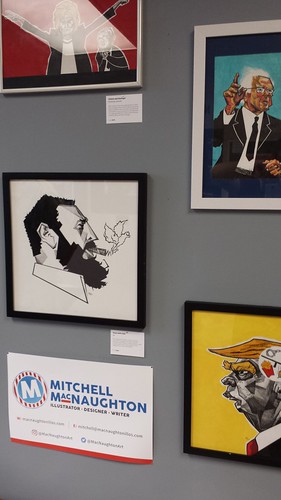
Why do you draw and comment on characters and events from the 1960s?
I find mid-century America fascinating because the dynamic of the country completely shifted in a handful of years. President Kennedy came to office on a wave of optimism as the U.S. came to terms with it’s post-war life, then his death is the first in a dark period that saw other assassinations along with riots and strife, and the decade comes to a close with the start of one of our lowest points of the modern century - The Vietnam War. It’s span of years that starts out on a high and bottoms out in a low, and for some reason that intrigues me.
